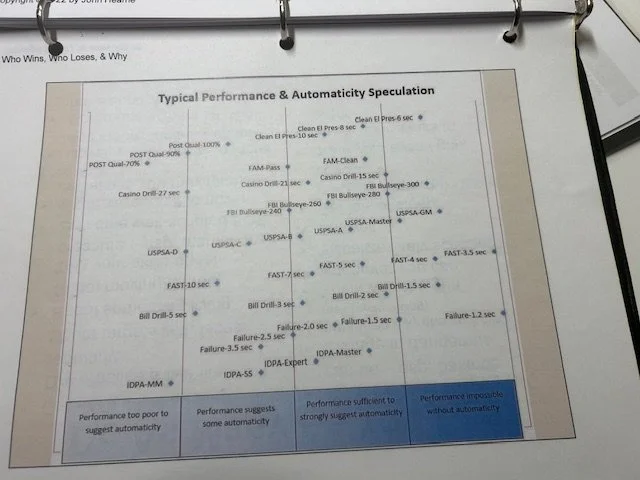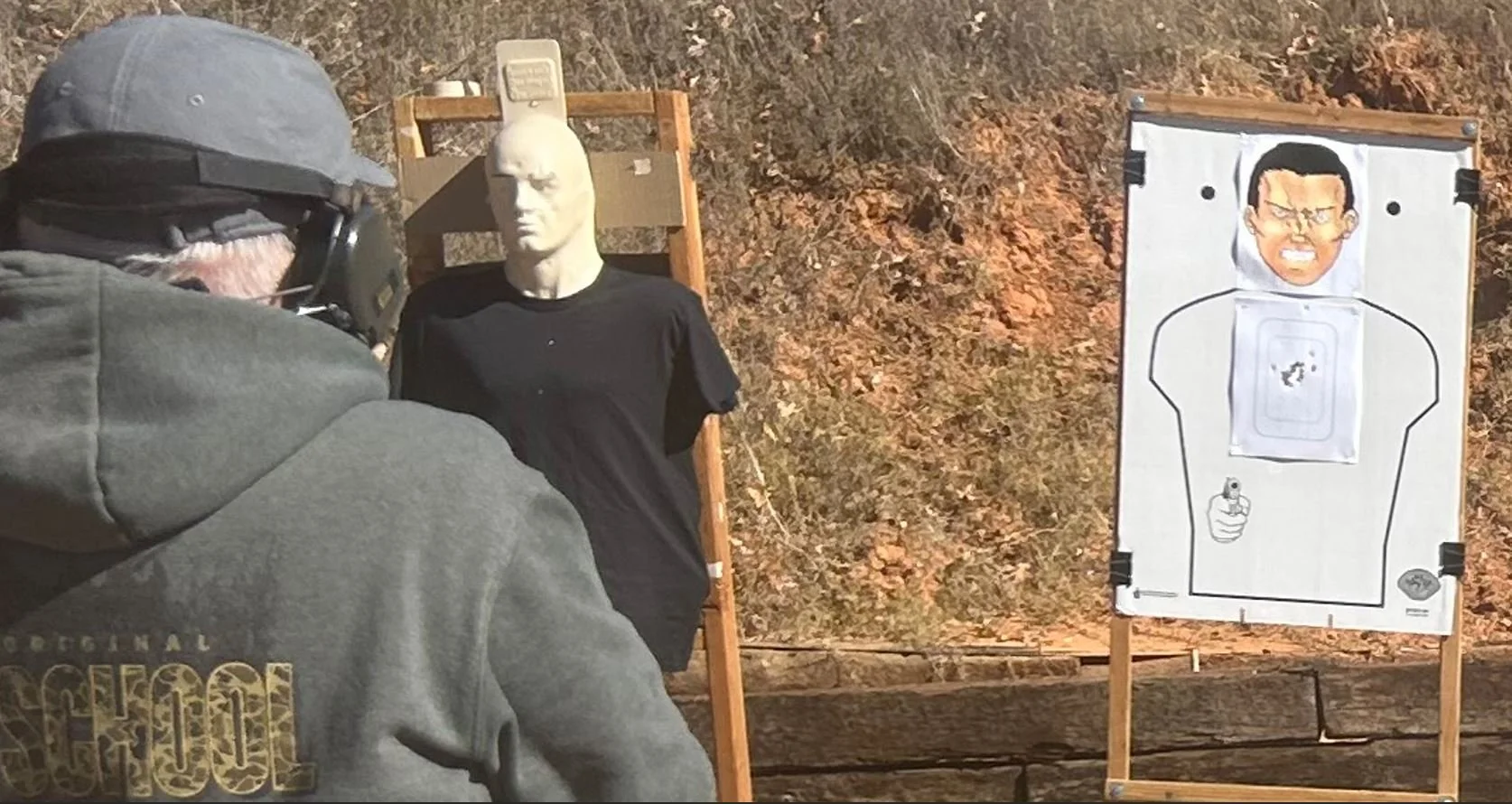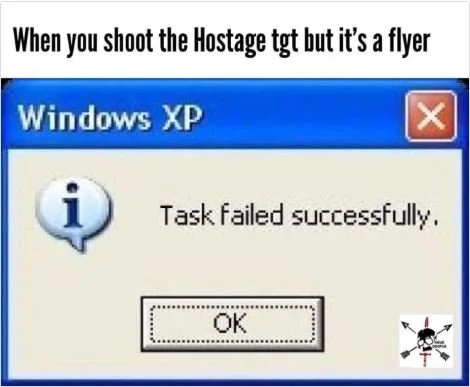AAR - TWO PILLARS TRAINING COGNiTIVE PISTOL WITH TACITCAL ANATOMY
Overview – I attended Two Pillars Training’s “Who Wins, Who Loses, & Why” and “Cognitive Pistol with Tactical Anatomy” classes from NOV 7 – 9, 2025. The class was run at Mead Hall Range, just outside of Oklahoma City, OK. Mead Hall is a small but well set-up range facility with a great indoor classroom and nice amenities. Round count was about 600. Range fees were $30/day.
The class was taught by John Hearne, a retired federal LEO and lifelong student of the gun. He has a masters in Criminal Justice focused on research methodology (Nerd!!). The classes were attended by eight and seven (respectively) students from varying backgrounds and professions. All the shooters in the class showed a high level of skill, and excellent gun handling. I didn’t see any safety issues on the line during the class.
GEAR – On day one of the pistol class I wore the same holster and magazine pouch that I wear day to day as a CCW rig, and shot from concealment. The holster is from JM Custom Kydex. The magazine pouch is from Blue Force Gear. A TQ from Snake Staff Systems lives in the second pocket in the magazine pouch. On day two I wore the same belt kit I use when I’m teaching overt stuff and didn't use a cover garment.
GUNS – Day one I shot my CCW pistol, a G19 with an RMR. On day two I shot my G45 w/Acro. Both guns ran well. I didn’t have any weapons issues that weren’t part of the class.
Respect for working a Princess Bride reference into the title of the class.
POI – This was a one-day class in the classroom, followed immediately by a two-day class that took place mostly on the range. You didn’t have to sign up for both, but most students did.
The first day was spent entirely in the classroom. “Who Wins, Who Loses, & Why” is a lecture/discussion-based class covering topics including how humans evolved, emotional control in high stress situations, how the brain stores and access information, and “other important stuff you really, really need to know”. The final section contained topics as varied as how the human eye works, how not to get shot by the police, and how to prioritize training time.
All of the information was presented in a very accessible way with lots of well-placed nerd references. There were good discussions about some of the topics, and John drew on the experiences of the people in the class while presenting the information. The purpose of the class is how to best prepare for a life and death struggle. The emphasis is on increasing your abilities with the hard skills to the point that you can run them while dealing with other issues. Students left the lecture with some solid “to-do” items, and good benchmarks for their training.
T-day 1 of the pistol class started back in the classroom. John covered the basics of human anatomy, psychological stops vs. physiological stops, how bullets perform, and the reality of pistols as fight stopping weapons. Once on the range we spent the first few minutes working dry through the draw stroke and presentation, as well as some supervised dry practice.
I didn’t speak with John about this, but I suspect starting the class that way has a couple of purposes. First it “tricks” people into a quick dry practice session, something we all need and know we should be doing but rarely do. Second it allows John, as an instructor, to watch everyone’s mechanics and make corrections before anyone has ammo in the gun.
Following the dry practice we shot some simple drills (pair to the body, head shot, failure drill) with an emphasis on putting the rounds where they will be most effective. The recommended hit area was a 4”x6” rectangle high in the chest with an acceptable margin of 5.5”x8.5” (conveniently the same size as a piece of printer paper folded in half). We shot similar drills with the course of fire being visually cued (with home built light boxes) and then visually dictated drills with visually cued starts. Think combining “Simon Says” and “Redlight, Greenlight” with a gun in your hand.
Doc is 80 some-odd years old and still getting after it.
We also spent some time shooting 3D targets. These targets were shot at different angles, then hits were assessed based on human anatomy. Between my medical background, my hunting experience, and my experience carrying a gun, there weren’t any “a-ha” moments. Either way, it was a cool way to illustrate the ideas. I also had a retired Navy MD as my partner on my target. Dude was in his 80s and shot absolutely lights out, so know there’s hope going forward.
Shots were analyzed for effectiveness after strings of fire
We wrapped the day with what John termed the “furball” drill (think messy, chaotic WW2 dogfight). This drill involved tightly packed targets and incorporated a mover. The targets were marked with various numbers/letters. You were given a number as a target and then had to find a good angle, from within a set space, to take the shot without hitting any of the other targets within the par time.
T-day 2 started back in the classroom with a discussion of the previous day, some additional information, and then one of the best approaches to the safety brief I think I’ve ever seen. John revisited the four weapons safety rules, then played videos of various ADs/NDs followed by discussion on which safety rule was violated, the result, and what steps could have been taken to mitigate/eliminate the issues. This was both entertaining and (for some in the class) eye opening.
Out on the range we started with a 15yd headshot on the clock (Hat tip to Jack Wilson) and the 5yd Round Up, shot on a head target. We then spent some time shooting variations of the Casino Drill. As I noted earlier, one of the things John emphasizes in the class is the ability to perform the hard skills (marksmanship and manipulations) under increased cognitive load. The Casino Drill is a good one for this. Particularly when you include dummy rounds in a couple of the magazines or a failure to feed round gets tossed into the mix.
One of the best ways to assess whether you’ve trained something to the point of unconscious competence is to introduce “secondary tasks” in the middle of a drill and then pick the drill back up right away. If you don’t have the ability to pause the primary task, address the secondary task, then pick the primary task back up, the primary task probably needs more work.
We rounded out the shooting day with some armed movement around people, some variations on the “Furball” drill and shooting some steel (both moving and static). After policing brass, we moved back to the classroom for a hotwash.
LESSONS LEARNED –
There is a difference between looking and seeing. - Okay, to say I “learned” this might be a bit of a misnomer. Those of you who have been in the shoot house with me know that I talk about this frequently. But the way the light boxes were incorporated into the drills really brought the point home. I saw a number of shooters get so into their sights that they missed light changes (to stop/start shooting, shoot different targets, etc.) or get so focused on the target they were trying to shoot that they tuned out the targets in the foreground/background and have shoot throughs into targets that they weren’t supposed to engage. This never happened to me of course. But if it did, and the target in the background that caught a bullet happened to also be designated as a shoot target, I totally did it on purpose.…
Moving targets don’t have to be complex. – John’s design for his moving target was brilliantly, unbelievably low tech and I’m stealing it to incorporate into training. Movers are one of the most useful, and least shot, targets out there. Looking forward to working that into range days.
Talk is cheap. If you’re not training it, you won’t do it – Most of us train firearms stuff in a “closed loop”. On command, draw, do the pre-designated thing until it’s done. Life doesn’t happen in a closed loop. You have to be able to assess the situation for the appropriate response. Incorporating things like drawing to a ready (rather than shooting every time you draw a gun), interrupting strings of fire with other tasks, incorporating verbal commands, practicing post-shooting procedures, etc. can all help to open the loops of our training.
For me, the biggest thing was solving the problem, then putting the gun away. I've talked to, and shot with, enough cops to know you don't want to have a gun in your hand when LE gets on scene. Even playing that game, I still reverted to my "rangeism" of just going back to a ready position and waiting for the next string. "Drawing aggressively and holstering reluctantly" is usually good advice. But getting domed by responding LE because when they show up, you're standing there all heroic with a gun in your hand would be a bummer. I know that, but I don't train that. So I wasn't doing it.
OVERALL - At this point in my training, I don’t expect to come away from classes with big revelations. I attend classes hopeful that I can grab one or two nuggets of information to incorporate into my training/mindset/knowledge base. John’s class certainly offered me that. The emphasis on finding ways to increase cognitive load during training once a baseline level of competence has been reached is something that I’ve known and understood for years but have been lazy about doing lately. This is not a “shoot lots, shoot fast” type of class. This is much more about shooting the right thing, in the right place, at the right time. If you make the opportunity to attend, I don’t think you’ll be disappointed.










